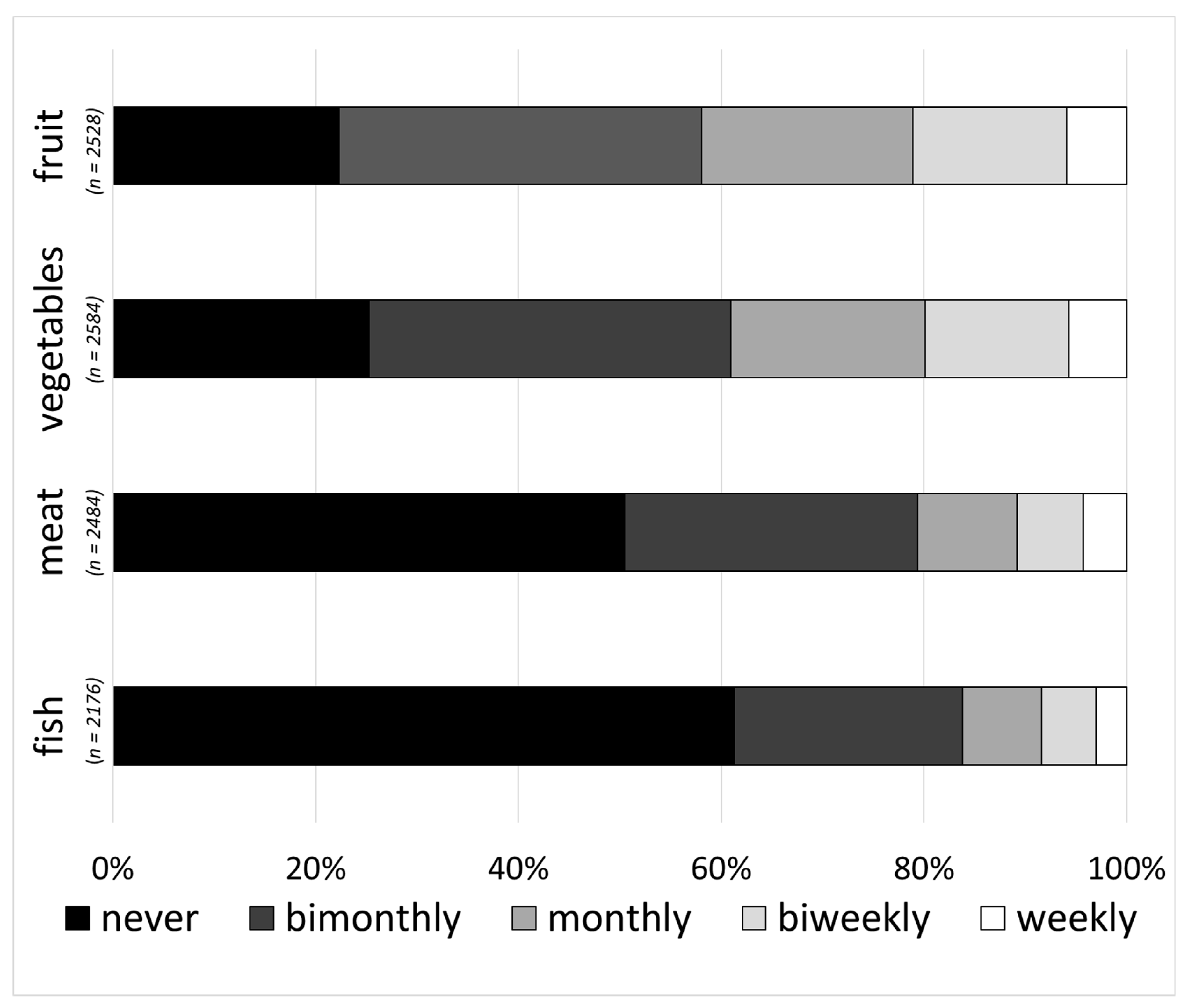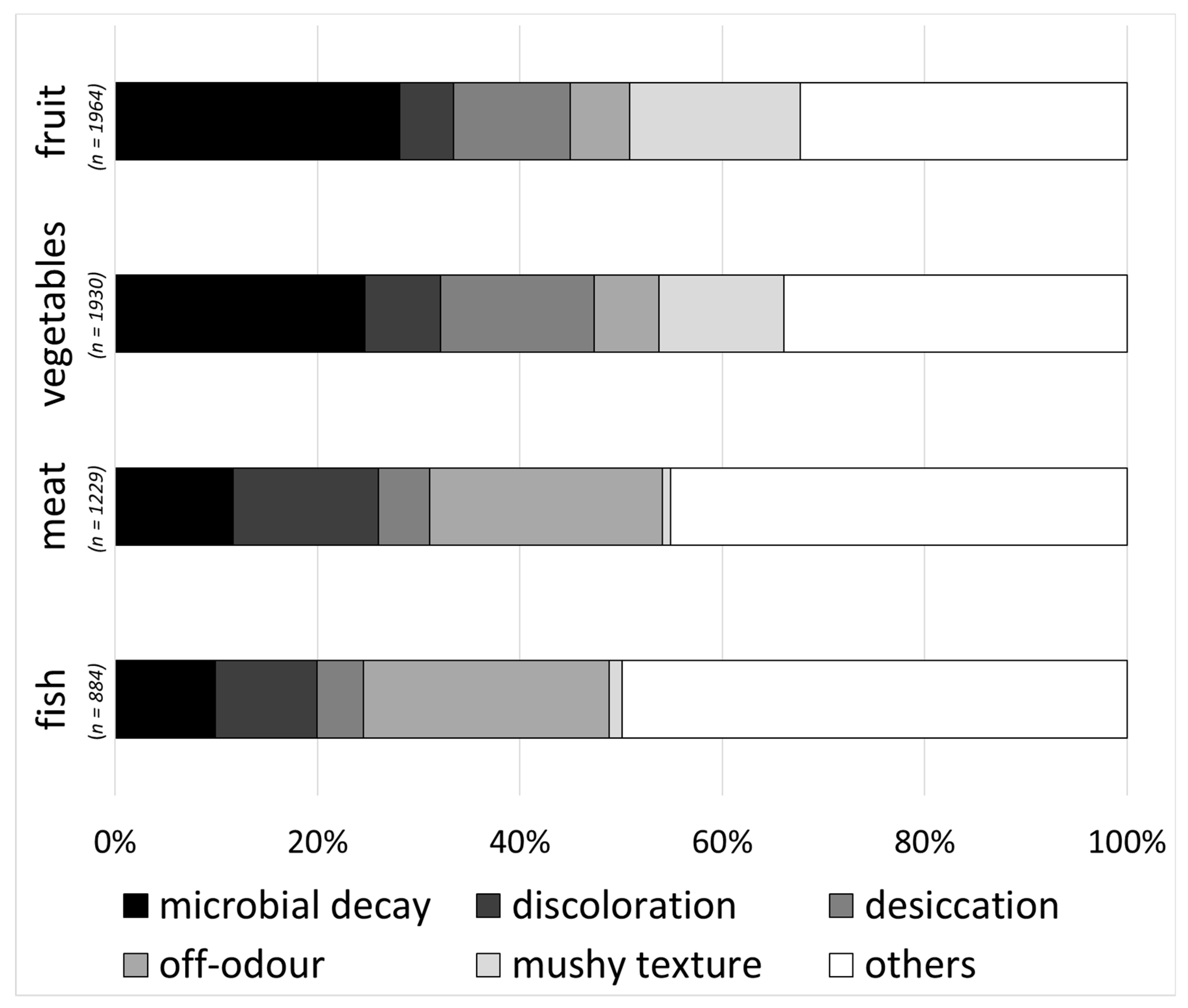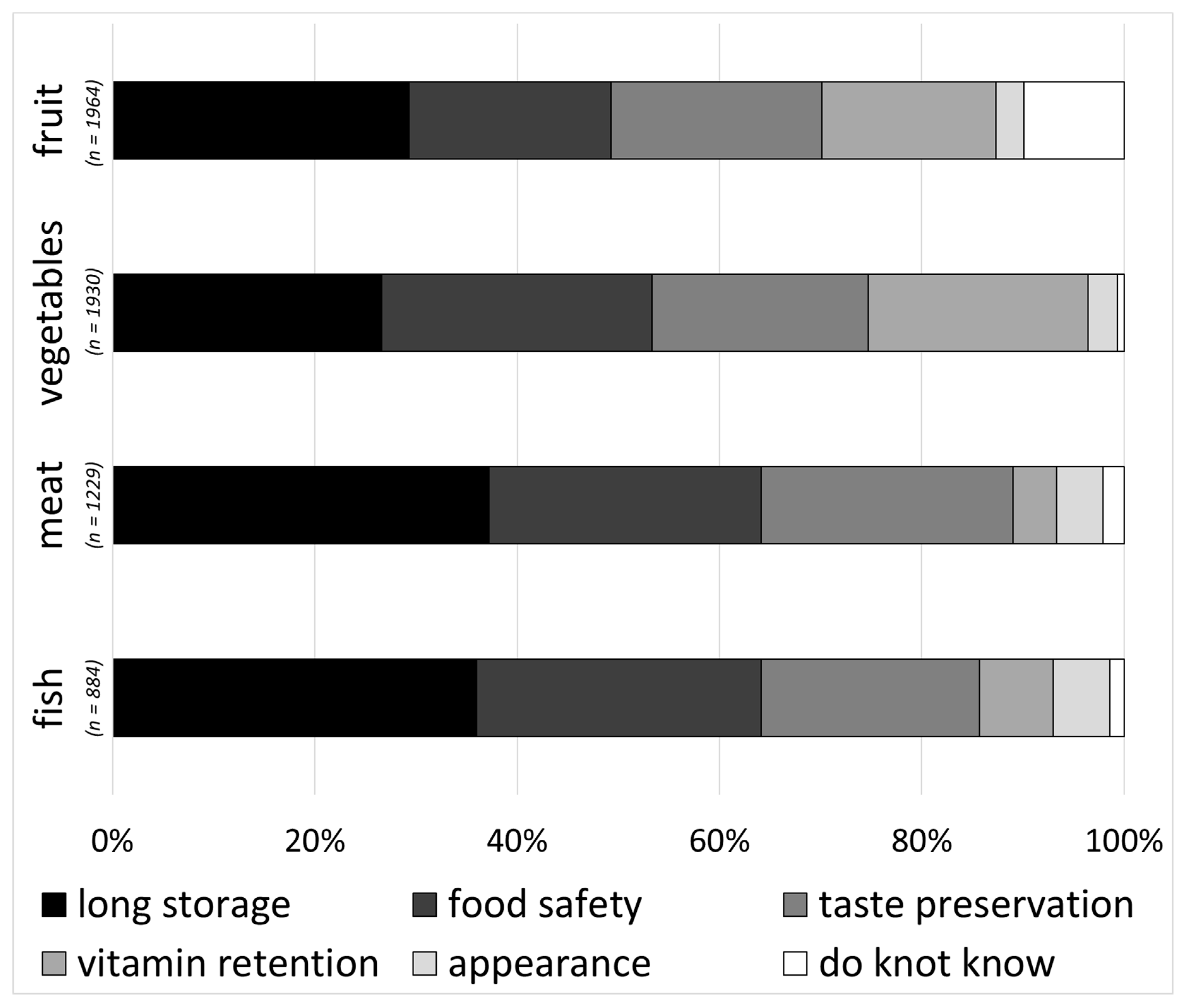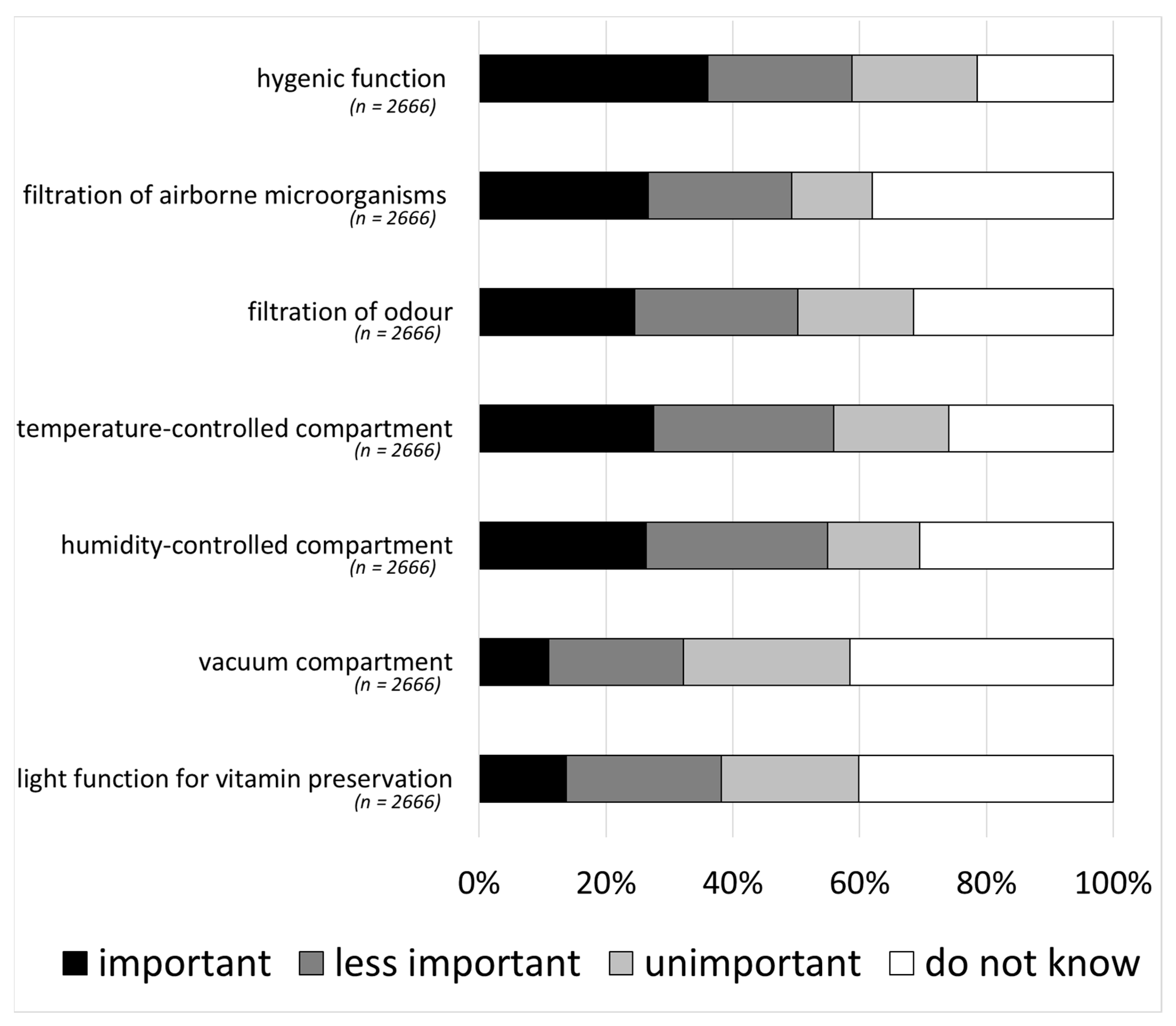Tackling Food Waste: Impact of German Consumer Behaviour on Food in Chilled Storage
Abstract
1. Introduction
2. Materials and Methods
2.1. Consumer Survey
2.1.1. Sampling Plan
2.1.2. Questionnaire
2.2. Data Analysis
3. Results
3.1. Demographics and Appliance Characteristics
3.2. Basic Consumer Behaviour in Refrigerator Storage
3.3. Food Waste and Impact Factors
3.4. Consumer Expectations and Demands Related to Refrigerator Performance
4. Discussion
4.1. Consumer Food Storage Behaviour and Refrigerator Feature Requirements
4.2. Potentials of Food Storage Improvement within Refrigerators
5. Conclusions
Supplementary Materials
Author Contributions
Funding
Acknowledgments
Conflicts of Interest
Ethical statement
Appendix A
- (1)
- Gender (male/female)
- (2)
- How old are you? (<18; 18–29; 30–39; 40–49; 50–59; 60–69; 70+)
- (3)
- Age group (18–39; 40–49; 50–69)
- (4)
- How many people perpetually live in your household? (1; 2; 3; 4; more)
- (5)
- Who in your household is mainly responsible for grocery shopping and food preparation? (me; another person; shared)
- (6)
- Type of main refrigerator (size; number of doors; fridge; fridge-freezer; side by side; French door)
- (7)
- Type of additional refrigerator (size; number of doors; fridge; fridge-freezer; side by side; French door)
- (8)
- Building type of main refrigerator (freestanding; built-in)
- (9)
- How many drawers does your main refrigerator have in addition to the vegetable drawer in the compartment? (0; 1; 2; 3+)
- (10)
- Brand of main refrigerator
- (11)
- Were you involved in the purchase decision for your current main refrigerator? (yes; no)
- (12)
- How old is your current main refrigerator in age groups? (<2; 2–5; 6–10; <10; do not know)
- (13)
- How old is your current main refrigerator in years? (1–50; do not know)
- (14)
- Which aspects are of particular importance to you when keeping fruit/vegetables/meat/fish in refrigerators fresh? (long storage time; vitamin retention; microbial safety; taste preservation; appearance; do not know)
- (15)
- Do you notice a loss of freshness of fruit/vegetables/meat/fish? (no; rarely; often)
- (16)
- How long do you usually store fruit/vegetables/meat/fish on average until completely consumed? (less than 1 day; max. 3 days; max. 5 days; about 1 week; about 2 weeks; more than 2 weeks)
- (17)
- Indicate the average loading degree in your refrigerator compartment (maximum; average; low; no load)
- (18)
- Indicate the average loading degree in your vegetable drawer (maximum; average; low; no load)
- (19)
- Where in the refrigerator do you store fruit/vegetables/meat/fish most often? (top shelf; mid shelf; bottom shelf; door rack; vegetable drawer; other drawer; not in refrigerator)
- (20)
- With what packaging do you usually store fruit/vegetables/meat/fish in the refrigerator? (original packaging; repackaged; unpackaged)
- (21)
- How often do you throw away fruit/vegetables/meat/fish because they are no longer edible? (weekly; every second week; monthly; every second month; never)
- (22)
- Why do you throw away fruit/vegetables/meat/fish? (microbial decay; discoloration; desiccation; off-flavours; off-odour; forgotten; bought too much; uncertain if still edible; mushy texture; other)
- (23)
- How often do you clean the refrigerator/vegetable drawer/shelfs/other areas? (weekly; monthly; semi-annually; when required; never)
- (24)
- When do you clean the refrigerator/vegetable drawer/shelfs/other areas? (regular intervals; to remove food scraps; to remove moisture; to remove off-odours)
- (25)
- Which aspects are of particular importance for you when cleaning? (overall accessibility; accessibility of edges; dry well; dishwasher-safe; parts are easily removable)
- (26)
- What do you normally use to clean your refrigerator? (dish detergent; vinegar-based cleaner; warm water; cold water; glass cleaner; hygienic cleaner; dish washer; other)
- (27)
- What do you normally use to dry cleaned areas? (dish towel; paper towel; air drying; in dish washer; other; I do not dry the cleaned areas)
- (28)
- Do you observe moisture in the form of (frozen) drops or a water film in the fridge? (often; sometimes; barely; never)
- (29)
- Where do you observe moisture? (vegetable drawer; bottom shelf; other shelfs; door seal; on food; back wall; other)
- (30)
- What do you do if you observe moisture in the refrigerator? (remove instantly; remove when large quantities occur; remove with next cleaning; I do not remove the moisture)
- (31)
- Why do you remove moisture in the refrigerator? (fosters growth of bacteria and mould; fosters discoloration; fosters mushy texture; fosters off-odours; fosters off-flavours; is unhygienic)
- (32)
- Are temperature-controlled compartments/humidity-controlled compartments/vacuum drawers/filtration of odour/hygienic functions/filtration of airborne microorganisms/light for vitamin preservation an important feature for you? (important; less important; not important; do not know)
References
- Parfit, J.; Barthel, M.; Macnaughton, S. Food waste within supply chains: Quantification and potential for change to 2050. Philos. Trans. R. Soc. B Biol. Sci. 2010, 365, 3065–3081. [Google Scholar] [CrossRef]
- Gustavsson, J.; Cederberg, C.; Sonesson, U. The Methodology of the FAO Study: Global Food Losses and Food Waste—Extent, Causes and Prevention; Food and Agriculture Organization of the United Nations: Rome, Italy, 2011; Available online: http://www.diva-portal.org/smash/get/diva2:944159/FULLTEXT01.pdf (accessed on 27 September 2020).
- Joerissen, J.; Priefer, C.; Braeutigam, K.R. Food waste generation at household level: Results of a survey among employees of two European research centers in Italy and Germany. Sustainability 2015, 7, 2695–2715. [Google Scholar] [CrossRef]
- Thomas, S. Erhebung des Verbraucherverhaltens bei der Lagerung Verderblicher Lebensmittel in Europa. In Schriftenreihe der Haushaltstechnik Bonn; Herzogenrath, S., Ed.; Shaker Verlag: Düren, Germany, 2007. [Google Scholar]
- Kemna, R.; van Holsteijn, F. Preparatory/Review Study on Commission Regulation (EC) No. 643/2009 and Commission Delegated Regulation (EU) No. 1060/2010—Complementary Research on Optimal Food Storage Conditions in Refrigeration Appliances; VHK Research: Delft, The Netherlands, 2017; Available online: https://www.vhk.nl/research/reports.htm (accessed on 27 September 2020).
- Hanssen, O.J.; Syversen, F.; Sto, E. Edible foodwaste from Norwegian households—Detailed foodwaste composition analysis among households in two different regions in Norway. Resour. Conserv. Recycl. 2016, 106, 146–154. [Google Scholar] [CrossRef]
- Secundi, L.; Principato, L.; Lauretti, T. Household food waste behaviour in EU-27 countries: A multilevel analysis. Food Policy 2015, 56, 25–40. [Google Scholar] [CrossRef]
- Edjabou, M.E.; Petersen, C.; Scheutz, C.; Astrub, T.F. Food waste from Danish households: Generation and composition. Waste Manag. 2016, 52, 256–268. [Google Scholar] [CrossRef]
- Waste and Resources Action Programme (WRAP). Household Food and Drink Waste; WRAP: Banbury, UK, 2009; Available online: https://www.wrap.org.uk/sites/files/wrap/Household_food_and_drink_waste_in_the_UK_-_report.pdf (accessed on 27 September 2020).
- Schmidt, T.; Schneider, F.; Claupein, E. Lebensmittelabfaelle in Privaten Haushalten in Deutschland—Analyse der Ergebnisse Einer Repraesentativen Erhebung 2016/2017 von GfK SE; Thünen Working Paper 92; Econstor: Braunschweig, Germany, 2018. [Google Scholar]
- European Parliamentary Research Service (EPRS). Tackling Food Waste. The EU’s Contribution to a Global Issue. 2014. Available online: http://www.europarl.europa.eu/RegData/bibliotheque/briefing/2014/130678/LDM_BRI(2014)130678_REV1_EN.pdf (accessed on 27 September 2020).
- Food and Agriculture Organization of the United Nations (FAO). Global Food Losses and Food Waste—Extend Causes and Prevention. 2011. Available online: http://www.fao.org/docrep/014/mb060e/mb060e.pdf (accessed on 27 September 2020).
- Kraemer, J. Lebensmittelmikrobiologie, 6th ed.; Verlag Eugen Ulmer: Stuttgart, Germany, 2002; p. 131. [Google Scholar]
- Laguerre, O.; Duret, S.; Hoang, H.M.; Flick, D. Using simplified models of the cold chain equipment to assess the influence of operating conditions and equipment design on cold chain performance. Int. J. Refrig. 2014, 47, 120–133. [Google Scholar] [CrossRef]
- Jevsnik, M.; Hlebec, V.; Raspor, P. Consumers’ awareness of food safety from shopping to eating. Food Control 2008, 19, 737–745. [Google Scholar] [CrossRef]
- Masson, M.; Delarue, J.; Blumenthal, D. An observational study of refrigerator food storage by consumers in controlled conditions. Food Qual. Prefer. 2017, 56, 294–300. [Google Scholar] [CrossRef]
- Lagendijk, E.; Asséré, A.; Derens, E.; Carpentier, B. Domestic refrigeration practices with emphasis on hygiene: Analysis of a survey and consumer recommendations. J. Food Prot. 2008, 71, 1898–1904. [Google Scholar] [CrossRef]
- Moeser, A.; Yildiz, J. Still edible? Consumer behaviour and knowledge on handling food. Ernaehrungs-Umsch. 2015, 62, 204–210. [Google Scholar]
- Waste and Resources Action Programme (WRAP). Helping Consumers Reduce Fruit and Vegetable Waste: Final Report; WRAP: Banbury, UK, 2008; Available online: http://www.wrap.org.uk/sites/files/wrap/WRAP%20RTL044-001%20Final%20report.pdf (accessed on 27 September 2020).
- Waste and Resources Action Programme (WRAP). Consumer Insight: Date Labels and Storage Guidance: Determining Consumer Understanding and Use of Date Labels and Storage Guidance in Order to Reduce Household Food Waste; WRAP: Banbury, UK, 2011; Available online: http://www.wrap.org.uk/sites/files/wrap/Technical%20report%20dates.pdf (accessed on 27 September 2020).
- Moreb, N.A.; Priyadarshini, A.; Jaiswal, A.K. Knowledge of food safety and food handling practices amongst foodhandlers in the Republic of Ireland. Food Control 2017, 80, 341–349. [Google Scholar] [CrossRef]
- Lazou, T.; Georgiadis, M.; Pentieva, K.; McKevitt, A.; Iossifidou, E. Food safety knowledge and food-handling practices of Greek university students: A questionnaire-based survey. Food Control 2012, 28, 400–411. [Google Scholar] [CrossRef]
- Evans, E.W.; Redmond, E.C. Older adult consumer knowledge, attitudes and self-reported storage practices of ready-to-eat food products and risks associated with listeriosis. J. Food Prot. 2016, 79, 263–272. [Google Scholar] [CrossRef] [PubMed]
- Geppert, J.; Stamminger, R. Do consumers act in a sustainable way using their refrigerator? The influence of consumer real life behaviour on the energy consumption of cooling appliances. Int. J. Consum. Stud. 2010, 34, 219–227. [Google Scholar] [CrossRef]
- Cox, J.; Downing, P. Food Behaviour Consumer Research: Quantitative Phase; WRAP: Banbury, UK, 2007; Available online: https://jfoodprotection.org/doi/abs/10.4315/0362-028X.JFP-15-448 (accessed on 27 September 2020).
- Rocatto, A.; Uyttendaele, M.; Membre, J. Analysis of domestic refrigerator temperatures and home storage time distributions for shelf-life studies and food safety risk assessment. Food Res. Int. 2017, 96, 171–181. [Google Scholar] [CrossRef]
- Geppert, J. Modelling of Domestic Refrigerators’ Energy Consumption under Real Life Conditions in Europe. Ph.D. Thesis, Bonn University, Bonn, Germany, 2011. [Google Scholar]
- Chardon, J.; Swart, A. Food consumption and handling survey for quantitative microbiological consumer phase risk assessments. J. Food Prot. 2016, 79, 1221–1233. [Google Scholar] [CrossRef]
- James, C.; Bukola, A.O.; James, S.L. The use and performance of household refrigerators: A review. Compr. Rev. Food Sci. Food Saf. 2017, 16, 160–179. [Google Scholar] [CrossRef]
- Remington, M.C.A. The Effect of Freezing and Refrigeration on Food Quality; Clemson University: Clemson, SC, USA, 2017; Available online: https://www.semanticscholar.org/paper/The-Effect-of-Freezing-and-Refrigeration-on-Food-Remington/e578a1be08764c578b629cd0e0f6718133851940 (accessed on 27 September 2020).
- IEC 62552-2:2015. Household Refrigerating Appliances—Characteristics and Test Methods—Part 2: Performance Requirements; VDE Verlag: Berlin, Germany, 2015. [Google Scholar]
- Kays, S.J.; Paull, R.E. Postharvest Biology, 2nd ed.; Exon Press: Athens, GA, USA, 2004; pp. 177–190. [Google Scholar]
- Mintel. Fridge and Freezers—UK—April 2016; Mintel Marked Research, Mintel Group Ltd.: London, UK, 2016; Available online: https://reports.mintel.com/display/748215/# (accessed on 27 September 2020).
- Plumb, A.; Downing, P.; Parry, A. Consumer Attitudes to Food Waste and Food Packaging; WRAP: Banbury, UK, 2012; Available online: http://www.wrap.org.uk/sites/files/wrap/Report%20-%20Consumer%20attitudes%20to%20food%20waste%20and%20packaging_0.pdf (accessed on 27 September 2020).
- Bruns, K.; Fjord, A.; Grunert, K. Consumers’ Food Choice and Quality Perception; The Aarhus School of Business Publ.: Aarhus, Denmark, 2002. [Google Scholar]
- Van Rijswijk, W.; Frewer, L.J. Consumer perceptions of food quality and safety and their relation to traceability. Br. Food J. 2008, 110, 1034–1046. [Google Scholar] [CrossRef]
- StBA: Federal Statistical Office of Germany, Germany. German and Foreign Population by Sex, Germany. 2017. Available online: https://www.destatis.de/EN/Themes/Society-Environment/Population/Current-Population/Tables/lrbev02a.html (accessed on 27 September 2020).
- StBA: Federal Statistical Office of Germany, Germany. Population by Age Groups, Germany. 2017. Available online: https://www.destatis.de/EN/Themes/Society-Environment/Population/Current-Population/Tables/lrbev01.html (accessed on 27 September 2020).
- StBA: Federal Statistical Office of Germany, Germany. Households by Type of Household. 2017. Available online: https://www.destatis.de/EN/Themes/Society-Environment/Population/Households-Families/Tables/lrbev05.html (accessed on 27 September 2020).
- BMEL: Federal Ministry of Food and Agriculture, Germany. Der Wert von Lebensmitteln—Umfragen im Auftrag des BMEL. 2011. Available online: https://docplayer.org/15714593-Der-wert-von-lebensmitteln-umfragen-im-auftrag-des-bmelv.html (accessed on 10 October 2020).
- Van Holsteijn, F.; Kemna, R. Minimizing food waste by improving storage conditions in household refrigeration. Resour. Conserv. Recycl. 2018, 128, 25–31. [Google Scholar] [CrossRef]
- Aschemann-Witzel, J.; de Hooge, I.; Amani, P.; Bech-Larsen, T.; Oostindje, M. Consumer-related food waste: Causes and potential for action. Sustainability 2015, 7, 6457–6477. [Google Scholar] [CrossRef]
- Wang, G.; Wang, H.; Han, Y.; Xing, T.; Ye, K.; Xu, X.; Zhou, G. Evaluation of the spoilage potential of bacteria isolated from chilled chicken in vitro and in situ. Food Microbiol. 2017, 63, 139–146. [Google Scholar] [CrossRef] [PubMed]
- Lanfranchi, M.; Calabrò, G.; De Pascale, A.; Fazio, A.; Giannetto, C. Household food waste and eating behaviour: Empirical survey. Br. Food J. 2016, 118, 3059–3072. [Google Scholar] [CrossRef]
- Knowles, T.; Moody, R.; McEachern, M.G. European food scares and their impact on EU food policy. Br. Food J. 2007, 109, 43–67. [Google Scholar] [CrossRef]
- Marklinder, I.M.; Lindblad, M.; Eriksson, L.M.; Finnson, A.M.; Lindqvist, R. Home storage, temperatures and consumer handling of refrigerated foods in Sweden. J. Food Prot. 2004, 67, 2570–2577. [Google Scholar] [CrossRef] [PubMed]
- Mataragas, M.; Zwietering, M.H.; Skandamis, P.N.; Drosinos, E.H. Quantitative microbiological risk assessment as a tool to obtain useful information for risk managers—Specific application to Listeria monocytogenes and ready-to-eat meat products. Int. J. Food Microbiol. 2010, 141, 170–179. [Google Scholar] [CrossRef] [PubMed]
- Ishangulyyev, R.; Kim, S.; Lee, S.H. Understanding food loss and waste—Why are we losing and wasting food? Foods 2019, 8, 297. [Google Scholar] [CrossRef]
- Losasso, C.; Cibin, V.; Cappa, V.; Rocatto, A.; Vanzo, A.; Andrighetto, I.; Ricci, A. Food safety and nutrition: Improving consumer bevaviour. Food Control 2012, 26, 252–258. [Google Scholar] [CrossRef]
Publisher’s Note: MDPI stays neutral with regard to jurisdictional claims in published maps and institutional affiliations. |






| Demographic Characteristics | Survey No. of Respondents (n = 2666) (%) | Germany (%) | |
|---|---|---|---|
| Gender | |||
| Female | 1319 | 49 | 51 |
| Male | 1347 | 51 | 49 |
| Age of respondent (yrs.) 1 | |||
| 18–29 | 417 | 16 | ~25 2 |
| 30–39 | 678 | 25 | |
| 40–49 | 500 | 19 | 29 |
| 50–59 | 596 | 22 | |
| 60–69 | 475 | 18 | / 3 |
| Household size | |||
| 1 | 1276 | 48 | 42 |
| 2 | 837 | 31 | 34 |
| 3 | 281 | 11 | 12 |
| 4 | 203 | 8 | 9 |
| 5+ | 69 | 3 | 3 |
| Responsibility for food management | |||
| Fully | 2027 | 76 | |
| Jointly | 532 | 20 | |
| Someone else | 107 | 4 | |
| Appliance characteristics | |||
| Age of main refrigerator (yrs.) | |||
| <2 | 487 | 18 | |
| 2–5 | 932 | 35 | |
| 6–10 | 607 | 23 | |
| >10 | 540 | 20 | |
| Do not know | 100 | 4 | |
| Number of refrigerators in household | |||
| 1 | 1492 | 56 | |
| ≥2 | 1174 | 44 | |
| Food Categories | Maximum Storage Time (%) (n = 2.666) | |||||
| days | ||||||
| 1 | 3 | 5 | 7 | >7 | ||
| Fruit | 3.2 | 32.2 | 33.9 | 23.7 | 7.0 | |
| Vegetables | 2.3 | 32.6 | 34.3 | 22.9 | 7.9 | |
| Meat | 13.7 | 46.5 | 21.4 | 12.9 | 5.5 | |
| Fish | 37.4 | 41.6 | 9.4 | 5.7 | 6.0 | |
| Most Common Storage Place (%) (n = 2666) | ||||||
| Storage Place | ||||||
| Vegetable drawer | Other drawer | Bottom | Mid | Top | Outside | |
| Fruit | 42.9 | 3.2 | 10.9 | 7.9 | 3.5 | 30.3 |
| Vegetables | 81.3 | 1.2 | 5.4 | 5.5 | 1.4 | 4.5 |
| Meat | 1.8 | 4.7 | 32.1 | 42.4 | 15.2 | 2.9 |
| Fish | 1.8 | 5.4 | 32.4 | 34.9 | 15.9 | 8.3 |
| Characteristic | Food Waste by Food Category (rsp) Weekly/Biweekly/Monthly/Bimonthly/Never | |||
|---|---|---|---|---|
| Fruit | Vegetables | Meat | Fish | |
| Age groups (yrs.) 18–29/30–39/40–49/50–59/60–69 | 0.263 ** | 0.289 ** | 0.256 ** | 0.232 ** |
| Household size (persons) 1/2/3/4/5+ | −0.140 ** | −0.135 ** | −0.123 ** | −0.121 ** |
| Storage time (d) Max. 1/3/5/7/>7 | −0.015 | −0.103 ** | −0.168 ** | −0.169 ** |
| Characteristic | Loss of Freshness by Food Category (rsp) Never/Rare/Often | |||
|---|---|---|---|---|
| Fruit | Vegetables | Meat | Fish | |
| Food waste Weekly/biweekly/monthly/bimonthly/never | −0.267 ** | −0.299 ** | −0.258 ** | −0.246 ** |
| Storage time (d) Max. 1/3/5/7/>7 | 0.085 ** | 0.094 ** | 0.036 | −0.005 |
| Importance of Storage Features Important/Less Important/Unimportant | Food Waste from Food Categories (rsp) Weekly/Biweekly/Monthly/Bimonthly/Never | |||
|---|---|---|---|---|
| Fruit | Vegetables | Meat | Fish | |
| Hygienic function | 0.139 ** | 0.134 ** | 0.154 ** | 0.164 ** |
| Filtration of airborne microorganisms | 0.087 ** | 0.084 ** | 0.086 ** | 0.040 |
| Temperature-controlled compartment | 0.127 ** | 0.121 ** | 0.097 ** | 0.150 ** |
| Humidity-controlled compartment | / 1 | 0.069 ** | / 1 | / 1 |
© 2020 by the authors. Licensee MDPI, Basel, Switzerland. This article is an open access article distributed under the terms and conditions of the Creative Commons Attribution (CC BY) license (http://creativecommons.org/licenses/by/4.0/).
Share and Cite
Wucher, H.; Klingshirn, A.; Brugger, L.; Stamminger, R.; Geppert, J.; Kölzer, B.; Engstler, A.; Härlen, J. Tackling Food Waste: Impact of German Consumer Behaviour on Food in Chilled Storage. Foods 2020, 9, 1462. https://doi.org/10.3390/foods9101462
Wucher H, Klingshirn A, Brugger L, Stamminger R, Geppert J, Kölzer B, Engstler A, Härlen J. Tackling Food Waste: Impact of German Consumer Behaviour on Food in Chilled Storage. Foods. 2020; 9(10):1462. https://doi.org/10.3390/foods9101462
Chicago/Turabian StyleWucher, Harald, Astrid Klingshirn, Lilla Brugger, Rainer Stamminger, Jasmin Geppert, Beate Kölzer, Antje Engstler, and Jochen Härlen. 2020. "Tackling Food Waste: Impact of German Consumer Behaviour on Food in Chilled Storage" Foods 9, no. 10: 1462. https://doi.org/10.3390/foods9101462
APA StyleWucher, H., Klingshirn, A., Brugger, L., Stamminger, R., Geppert, J., Kölzer, B., Engstler, A., & Härlen, J. (2020). Tackling Food Waste: Impact of German Consumer Behaviour on Food in Chilled Storage. Foods, 9(10), 1462. https://doi.org/10.3390/foods9101462







